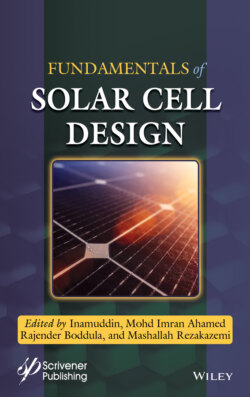Читать книгу Fundamentals of Solar Cell Design - Rajender Boddula - Страница 33
2.2.2 Mechanism of Plasmonic Solar Cells
ОглавлениеPlasmonic nanostructures are used as light harvesting antennas in thin film solar cells. Plasmonic nanostructures such as metallic nanoparticles or thin films are used to trap or concentrate light. They can be introduced at top or back surface as antireflecting coating in solar cells. Various fabrication techniques can be used to deposit metal nanoparticles. A simple technique is the evaporation followed by heat treatment for making arrays of metal nanoparticles. The lithography is also used for making metal nanoparticles [36, 37].
Figure 2.4 Approaches to integrate plasmonic nanoparticle in solar cell.
Plasmonic nanostructures can be used mainly in three manners. First, they can be positioned at the top surface as subwavelength scattering element in solar cell as shown in Figure 2.4a. The metallic nanoparticles dielectric particles are used to get scattering. Metallic nanoparticles are preferred because they can scatter more light than their geometry area. Second, a plasmonic nanostructure can be embedded at the interface or inside the absorber as shown in Figure 2.4b. The plasmonic resonance scatters the light inside the absorber layer and increases absorption at the interface. This design is more preferred in DSSC and single junction PV device. Third, the metallic nanostructure can be positioned as array of nanoparticle or very thin film at the back surface in solar cell as shown in Figure 2.4c. The light travels in a longer path and enhances the absorption. The plasmonic thin film does the task of light trapping and collection of charge carriers [38–40].
